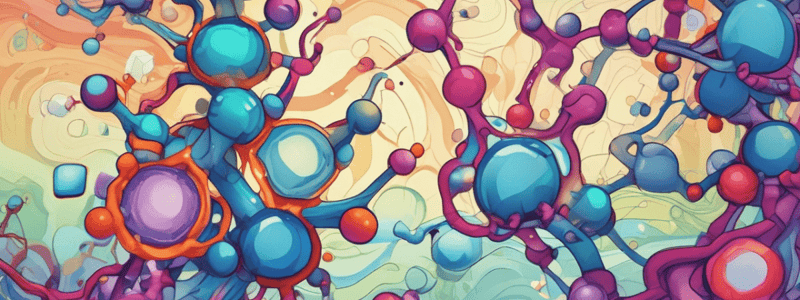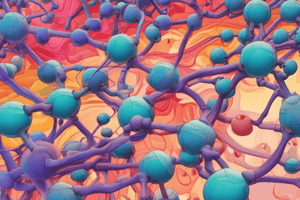Podcast
Questions and Answers
What is the result of incorporating a solvent into the structure of polymers?
What is the result of incorporating a solvent into the structure of polymers?
- Formation of a crystal
- Breakdown of the polymer
- Creation of a new polymer
- Formation of a gel (correct)
What is the purpose of polymers as film coatings in pharmaceutical applications?
What is the purpose of polymers as film coatings in pharmaceutical applications?
- To mask the unpleasant taste of a drug (correct)
- To modify drug release characteristics
- To enhance drug stability
- To create a crystalline structure
Which of the following is NOT a characteristic of an ideal polymer system?
Which of the following is NOT a characteristic of an ideal polymer system?
- Good mechanical strength
- Toxic (correct)
- Inert and compatible with the environment
- Easily administrable
What is an example of a polymer-based technology in drug delivery?
What is an example of a polymer-based technology in drug delivery?
What type of polymers are rarely 100% crystalline?
What type of polymers are rarely 100% crystalline?
What is the role of polymers in pharmaceutical applications?
What is the role of polymers in pharmaceutical applications?
What is the meaning of the word 'polymer'?
What is the meaning of the word 'polymer'?
What is the main difference between homopolymers and copolymers?
What is the main difference between homopolymers and copolymers?
What is the effect of cross-linking on the solubility of a polymer?
What is the effect of cross-linking on the solubility of a polymer?
What is the characteristic of a highly cross-linked polymer?
What is the characteristic of a highly cross-linked polymer?
What is the reason why highly cross-linked polymers do not melt?
What is the reason why highly cross-linked polymers do not melt?
What is the characteristic of linear polymers?
What is the characteristic of linear polymers?
What is the characteristic of branched polymers?
What is the characteristic of branched polymers?
What is formed when cross-linked polymers are added to solvents?
What is formed when cross-linked polymers are added to solvents?
Flashcards are hidden until you start studying
Study Notes
Polymers
- Polymers are substances of high molecular weight made up of repeating monomer units.
- Examples of polymers include proteins (monomer is amino acid) and polysaccharide (monomer is saccharide).
- The word "polymer" means "many parts".
Polymer Categories
- Polymers can be classified based on composition, with homopolymers having identical monomeric units and copolymers having more than one monomer type.
- Polymers can also be classified based on linkage and structure, with characteristics such as:
- Linear or Branched
- Crosslinking or not
- Crystalline or amorphous
- Entangled polymers with secondary bonding
Branched or Linear Polymers
- Polymers can be branched or linear, with branched polymers forming networks and having a low melting temperature.
- Linear chains have a higher chance of approaching each other in their solid state, increasing their crystallinity and melting temperature.
Polymer Crosslinking
- Linear or branched chains may be joined by crosslinks, restricting their movement and increasing their rigidity.
- Highly cross-linked polymers are very rigid (three-dimensional) structures that degrade at high temperatures before their chains start to move.
- Crosslinking sacrifices solubility for swellability.
Gels
- Gels are formed when crosslinked polymers are added to solvents (such as water), causing the polymers to swell but not dissolve.
- The incorporation of the solvent into the polymer structure leads to the formation of the gel.
- Polymers used to prepare gels are called gelling agents (e.g., carbapol).
Crystalline and Amorphous Polymers
- Polymers are rarely 100% crystalline, as it is difficult for all regions of all chains to become aligned.
- Crystalline regions are typically found alongside amorphous regions.
Pharmaceutical Applications of Polymers
- Polymers have a range of pharmaceutical applications, including:
- Binders in tablets
- Viscosity and flow controlling agents in liquids, suspensions, and emulsions
- Film coatings to mask unpleasant tastes
- Enhancing drug stability
- Modifying drug release characteristics (e.g., controlled release, targeted release, and improved bioavailability)
Characteristics of Ideal Polymer System
- Inert and compatible with the environment
- Nontoxic
- Easily administrable
- Easy and inexpensive to fabricate the dosage form
- Good mechanical strength
Studying That Suits You
Use AI to generate personalized quizzes and flashcards to suit your learning preferences.





